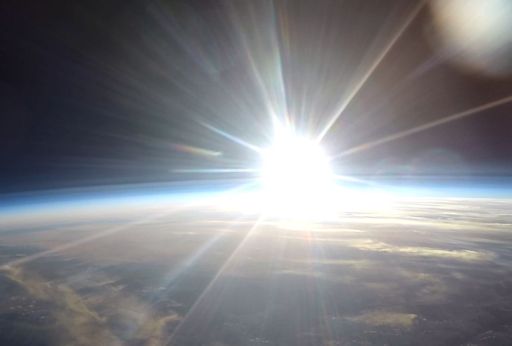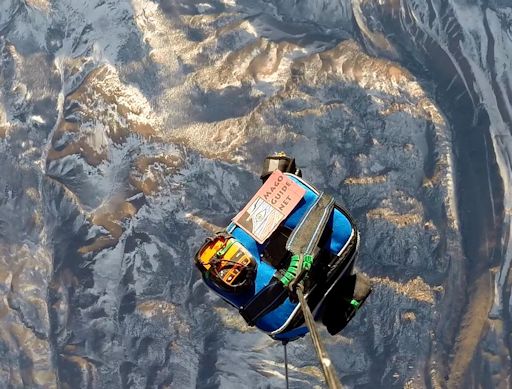Learn to photograph Northern Lights like a pro. Sign up for Peter Rosen's Aurora Photo Courses in Abisko National Park. | | |
GEOMAGNETIC UNREST: NOAA forecasters estimate a 50% to 65% chance of polar geomagnetic storms on Dec. 14-15. The source of the unrest is solar wind: Earth is dipping in and out of a series of high-speed streams. Arctic sky watchers should remain alert for auroras in the nights ahead. Aurora alerts: text, voice
GEMINID METEOR UPDATE: The Geminid meteor shower is peaking today, Dec. 14th, as Earth passes through a cloud of debris from rock comet 3200 Phaethon. Last night, NASA's network of all-sky cameras detected 145 Geminid fireballs over the USA alone. Halfway around the world in Sweden, "we also saw many meteors," reports astrophotographer P-M Hedén, who captured this one just before local sunrise:

It is likely that meteor rates will subside as Dec. 14th turns into Dec. 15th. However, that doesn't mean the show is over. The debris stream of 3200 Phaethon is broad, and many more Geminids remain to be seen in the nights ahead. No matter where you live, the best time to look is during the hours between 10 pm and sunrise (local time) when the constellaton Gemini is high overhead spitting embers of a rock comet across the starry sky.
Got clouds? No problem. You can still experience the Geminids by listening for their echoes in this live audio stream from Spaceweather.com's forward scatter meteor radar.
Realtime Meteor Photo Gallery
NEUTRONS DETECTED IN THE STRATOSPHERE: On Dec. 8th, using a suborbital helium balloon, the students of Earth to Sky Calculus launched new type of Space Weather Buoy to the stratosphere. Unlike previous buoys, which measured only X-rays and gamma-rays, Space Weather Buoy 2.0 is also sensitive to neutrons. This just in: The flight was a success. To learn about the results, scroll past this photo taken by an onboard camera as the sun was setting at 95,700 feet:

The payload was recovered intact from its landing site near the Eureka Dunes of Death Valley National Park. The neutron sensor returned full of data. Students are still working the numbers, and complete results are not ready to be shared. However, we can say this much now: An abundance of neutrons were detected during the 2 hour flight. Peak rates reached 240 neutrons per minute, compared to ~0 neutrons per minute at ground level.
Neutrons are an important form of cosmic radiation because they provide much of the biologically effective radiation dose at altitudes of interest to aviation and space tourism. Low-energy neutrons also cause single-event upsets in aircraft avionics, especially devices that contain Boron 10. Adding a neutron sensor to the Space Weather Buoy allows the students to monitor this type of radiation at altitudes ranging from ground level to 120,000 feet.
Hey thanks! The students wish to thank the generous folks at MagoGuide.net for sponsoring the flight. Their logo can be seen atop the payload as it ascended above the snowy Sierra Nevadas of centtral Californiia:

MagoGuide is a fantastic travel web site, providing global access to local knowledge to adventurers around the world. Their donation of $500 got this mission off the ground. Thanks again!
Potential sponsors, if you would like to support Earth to Sky Calculus and fly your logo to the edge of space, please contact Dr. Tony Phillips to make arrangements.
Realtime Space Weather Photo Gallery
EDGE OF SPACE CHRISTMAS CARDS: What do you give to the sky watcher who has everything? How about a Christmas card from the Edge of Space? For only $49.95, the students of Earth to Sky Calculus will fly your holiday greeting or favorite picture to the top of Earth's atmosphere, photograph it, and return the snapshot in time for Christmas. This holiday magic is performed using suborbital helium balloons. The group has previously flown cupcakes, shoes, US presidents, ad banners and telescopes. Contact Dr. Tony Phillips for more information.
Realtime Aurora Photo Gallery
Realtime Comet Photo Gallery
Every night, a network of NASA all-sky cameras scans the skies above the United States for meteoritic fireballs. Automated software maintained by NASA's Meteoroid Environment Office calculates their orbits, velocity, penetration depth in Earth's atmosphere and many other characteristics. Daily results are presented here on Spaceweather.com.
On Dec. 14, 2014, the network reported 222 fireballs.
(145 Geminids, 70 sporadics, 2 December Monocerotids, 2 , 2 December Leonis Minorids, 1 Comae Berenicid)

In this diagram of the inner solar system, all of the fireball orbits intersect at a single point--Earth. The orbits are color-coded by velocity, from slow (red) to fast (blue). [Larger image] [movies]
Potentially Hazardous Asteroids (
PHAs) are space rocks larger than approximately 100m that can come closer to Earth than 0.05 AU. None of the known PHAs is on a collision course with our planet, although astronomers are finding
new ones all the time.
On December 14, 2014 there were potentially hazardous asteroids.
Notes: LD means "Lunar Distance." 1 LD = 384,401 km, the distance between Earth and the Moon. 1 LD also equals 0.00256 AU. MAG is the visual magnitude of the asteroid on the date of closest approach. | | The official U.S. government space weather bureau |
| | The first place to look for information about sundogs, pillars, rainbows and related phenomena. |
| | Researchers call it a "Hubble for the sun." SDO is the most advanced solar observatory ever. |
| | 3D views of the sun from NASA's Solar and Terrestrial Relations Observatory |
| | Realtime and archival images of the Sun from SOHO. |
| | from the NOAA Space Environment Center |
| | the underlying science of space weather |

